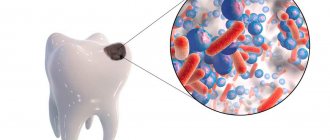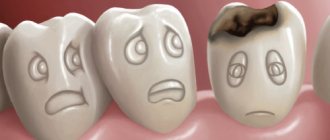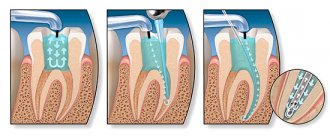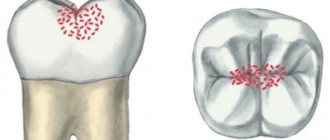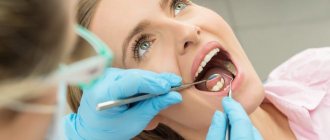Fluoridation: strengthening and protecting teeth
Since childhood, we have all been told that we need to eat less sweets and more fresh fruits, vegetables and dairy products. And why all? They contain useful vitamins and minerals that support the health of the body, give energy and strength. Our teeth also need additional nutrition. When teeth are strong from the inside, they are better able to withstand external influences, which means that the risk of caries is reduced significantly. How to strengthen and restore tooth enamel? What is fluoridation and why is fluoride varnish needed?
Why should you entrust caries treatment to the specialists of the InWhite Medical clinic?
- We treat caries using modern minimally invasive methods and technologies that have proven their effectiveness.
- Caries therapy at the level of the carious spot is carried out without the use of a drill - using light-polymer materials of the ICON system. The hard tissue of the tooth remains intact, and the development of the carious process stops.
- When treating caries, we care about aesthetics. To do this, we carefully select the color of the filling to match the natural shade of the teeth. If their surface is severely damaged, we make every effort to restore it through artistic restoration.
- We strive to provide each patient with maximum psychological comfort when visiting our clinic.
If you need caries treatment in Moscow, choose a professional, modern clinic that uses all the latest advances in dentistry.
What is dental fluoridation?
This is a procedure for strengthening enamel, during which a specialist applies a preparation containing useful microelements to the teeth, the main of which are fluoride and calcium.
The special composition penetrates deep into the enamel, fills the pores, thereby restoring and strengthening its structure. A protective barrier against bacteria is formed on the teeth. Why is it important to have fluoridation done by a dentist? The fact is that the procedure is especially effective when the enamel is clean and polished. Often, strengthening teeth is the final stage of professional oral hygiene. The specialist first carries out ultrasonic and abrasive cleaning of stone and plaque, and then saturates the enamel with minerals. This way it better absorbs all the useful components.
Materials for the treatment of caries
In modern dentistry, various filling materials are presented for the treatment of caries, each of which has its own physicochemical characteristics.
Conventionally, all filling materials for dental treatment can be divided into several types:
- Compositions for permanent fillings - with their help you can treat dental caries with a long-term effect. Fillings made from such materials provide the possibility of reliable restoration of damaged anatomy.
- Compositions for temporary fillings - their installation is required for the treatment of pulpitis and periodontitis. The purpose of such materials is to provide temporary closure of the exposed carious canal.
- Filling pastes, which are used as a medicinal lining, on top of which a permanent filling is applied.
- Materials for filling molars.
Fluoridation of teeth for children: benefit or harm?
The child’s baby teeth are not yet strong: they have fragile enamel, followed by a thin dentin layer, and at the base there is a soft pulp chamber with nerve endings and blood vessels. Therefore, children's teeth are more easily damaged; caries often forms on them, which can quickly develop into complications. It seems like just yesterday there was a small dark spot on the enamel, and today your child is complaining of severe toothache and refuses to eat.
To reduce the risk of tooth decay, baby teeth need to be cleaned regularly and properly, and strengthened. How can you help your children maintain a beautiful smile and protect them from toothache? With the appearance of the first teeth, bring your child to the dentist for a preventive examination 2-3 times a year. The pediatric dentist will promptly identify possible problems, teach in a playful manner the correct technique for brushing teeth, and also carry out fluoridation that is beneficial for the enamel.
How does dental caries occur?
At least once in their life, everyone has been to the dentist and had their teeth treated, but not many people know what dental caries is as a pathological process.
It develops when bacterial biofilm (plaque) converts sugars from carbohydrate foods into organic acids. The latter work as solvents of tooth enamel and dentin, consistently destroying the tooth structure. With a large amount of plaque, increased production of acids occurs, which leads to the rapid development of caries.
Thus, if a person consumes large quantities of carbohydrates for a long time, neglects brushing his teeth or does not remove plaque well, the body does not receive minerals in the required quantities, and the teeth are destroyed. First, a small focus of demineralization appears on the enamel, which looks like a light spot, then a cavity appears in the enamel layer. If the teeth are not cured at this stage of superficial caries, the destruction affects the dentin - it goes into the stage of first medium and then deep caries. The stronger and deeper the carious lesion, the more difficult and painful the treatment of caries will be, the greater the risk of complications, including tooth loss. Therefore, it is important to treat it immediately when the first symptoms appear.
Simple fluoridation of teeth
The most common way to strengthen teeth. It is used to prevent caries. A special composition is applied to the enamel, which forms a thin protective film. What kind of composition is this? Fluoride varnish, fluorine-containing varnish, fluoride varnish or simply enamel restoration varnish - the strengthening agent has several names, but the result is the same. Your teeth are reliably protected, and the effect lasts up to six months.
Is anesthesia necessary when treating caries?
When treating caries using microinvasive methods, anesthesia is not required, since these methods do not involve the use of a drill and are painless in themselves. If we are talking about the treatment of level 3 or 4 caries with opening of the carious cavity and filling, local anesthesia is necessary.
Modern dentistry has a variety of latest generation anesthetics. They are affordable, do not cause allergies, and are suitable for pregnant women and children. In any case, the anesthetic is selected by the doctor individually for each patient.
Deep fluoridation of teeth
This is a more effective way to strengthen enamel.
For deep fluoridation, a more saturated fluorogel is used. It acts not only on the surface of the teeth, but also penetrates into the deep layers of enamel. Useful microelements, as a building material, restore the structure of the tooth, preventing the development of initial caries. The strengthening effect lasts up to a year. Fluoridation of teeth has a positive effect in most cases.
But before carrying out the procedure, you must consult a specialist. Oversaturation of enamel with fluoride, as well as its lack, are equally harmful to health. Do you want your teeth to be strong? Take care of them. Take just one day out of your busy schedule and visit the dentist. Fluoridation will strengthen the enamel for a long time and protect teeth from caries.
Commenting system SigComments
Back to section
How is caries treated with laser?
Laser treatment of caries is a modern non-contact method. The laser beam passes into the dental tissue to the depth required for treatment. It removes affected tissue, disinfects, and reduces the likelihood of bleeding. At the same time, the laser does not damage healthy tissue.
The advantages of laser treatment of dental caries are the minimal risk of complications, the ability to control the intensity and depth of the effect. With all its advantages, the laser is effective in the early stages of caries, like other non-invasive methods.
Types of caries
Since the method of treatment depends on the type of disease, it is customary to distinguish between the following types of caries:
- superficial (with defects on the surface layer of enamel);
- medium (affects dentin);
- in the stage of darkening of the enamel (pigmentation on the surface of the tooth does not cause significant destruction);
- deep (affects the entire dentin layer).
This is a classification based on the depth of dental damage.
It is important to start treatment of medium and deep caries on time. Medium caries can cause tooth pulpitis and cause pain in the patient. Sometimes caries damage to dental tissue develops so quickly that the doctor is unable to save the diseased tooth and has to remove it. This is why it is so important to diagnose the disease on time.
Caries is often divided into primary and secondary. In the primary form, it becomes clear that this affected area has never been treated before. Secondary caries is a clear sign that a carious cavity has already appeared under an installed dental crown or filling.
Depending on the degree of localization, caries can be:
- fissure (appears in natural depressions on the surface of the teeth);
- cervical (the lesions are located near the gums);
- interdental (often affects the front teeth).
According to the rate of progression, caries can be of the following types:
- slow flowing;
- stabilized;
- fast-flowing.
In addition, the World Health Organization distinguishes several more types of this disease, based on the type of tissue affected, namely:
- enamels;
- dentin;
- cement;
- pulp exposure.
Tooth root caries: is it possible to treat and save the tooth?
Tooth root caries most often has to be treated in an advanced stage, since the gums prevent you from seeing the carious damage in this area. Therefore, patients come to the doctor only when the tooth begins to hurt.
Is it possible to treat and save a tooth with tooth root caries? The answer to this question will depend on how much the disease has damaged the tooth root. If the damage is significant, treatment will be carried out either by surgical methods, or the dentist will recommend that you remove the tooth and later restore it with prosthetics or implantation.
Professional procedures - modern caries prevention
Preventive measures can be applied at home, but there are also professional ones.
Modern dentistry provides a number of useful manipulations for the successful removal of dental plaque and restoration of mineral balance. It is recommended to have a professional cleaning done at your doctor's office twice a year. If the oral cavity is in good condition, this is enough to maintain health. Patients who wear bite alignment appliances should undergo this procedure at least three times a year. The same goes for people who frequently drink coffee or tea, as well as smokers. In this case, they develop pigmented plaque too quickly and require regular cleaning.
Professionals identify several types of caries prevention using:
- Air Flow - used to remove soft deposits. A mixture consisting of water, gentle abrasive components and air is sprayed onto the teeth and delicately cleanses their surface.
- Ultrasound - helps get rid of hard deposits called stones.
These are common types of cleaning, but in some cases other methods can be used, for example, if the patient has large subgingival stones. Finally, the surface is polished to a smooth finish, which helps prevent future plaque buildup.
Fluoroprophylaxis and remineralization
As an effective measure for the prevention of dental caries, dentists use fluoride-containing preparations. The principle of their operation is very simple. Tiny fluoride particles penetrate the enamel structure, saturate it and restore it. As a result, resistance to the negative effects of external acids increases. Moreover, the component inhibits the development of pathogenic bacteria, which is why plaque does not form as intensively.
Professional remineralization with fluoride
To maintain oral health, it is very important to maintain the mineral balance of hard tissues. In normal condition, the enamel layer provides effective protection against the influence of adverse factors and prevents tooth decay. If a person eats a lot of sweets or is not concerned enough about hygiene, a gap appears in this barrier.
Remineralization is an effective way to prevent caries. Allows you to restore the natural structure of the enamel. For this, doctors use special formulations with fluoride and calcium. They replenish mineral deficiencies, strengthen the protective barrier and reduce sensitivity.
Various methods of applying drugs are used:
- direct;
- baths;
- rubbing;
- applications;
- electrophoresis;
- rinsing.
Dentists at the Dentika clinic will professionally restore thinned enamel, eliminate erosions, cracks and other damage.
Fissure sealing
There are natural grooves on the chewing surface of the teeth. For some people, their anatomy causes food particles to accumulate in these areas that are difficult to remove during routine brushing. Sealing the recesses completely solves this problem.
This procedure is also used to prevent the early development of caries in children. Using a special sealant, dentists mechanically seal the fissures. At the Dentika clinic, modern and high-quality compounds are used for these purposes: Fluoride varnish, Composeal and Duraphat.
Stages of caries
Everything related to this disease - symptoms, treatment methods, etc. – depends on the degree and stage of caries.
There are four stages of the disease:
- Spot. In this case, only the pigmentation of the enamel changes, that is, a dot or speck appears on its surface.
- Surface. At this stage, the doctor diagnoses damage to the shiny enamel layer of the tooth.
- Median. With this disease, pathogenic microbes eat away the hard tissues inside the crown of the tooth - dentin.
- Deep. This is the most dangerous type of caries, in which the degree of damage is so global that there is practically no partition left between the carious lesion and the chamber in which the pulp is located.
Is it possible to cure caries under general anesthesia?
Some patients think that teeth can be treated without pain only under general anesthesia, and therefore they are interested in whether general anesthesia is used in the treatment of caries. Theoretically, the use of general anesthesia in the treatment of caries is possible, but in practice, this method of pain relief is used only for serious surgical interventions - complex tooth extraction, implantation.
General anesthesia has a lot of contraindications, recovery from it is accompanied by discomfort and various side effects, so using general anesthesia simply to treat caries is inappropriate. Without pain, teeth can be treated under local anesthesia or sedation, which do not have such a wide range of restrictions on use and do not give any side effects after use.
YOU NEED TO REMEMBER! Knowing that patients want to have their teeth treated quickly and without pain, some clinics still offer dental treatment under general anesthesia. Before you contact such a dentistry, find out the level of its equipment! To use general anesthesia when working with patients, the clinic must have the appropriate equipment, and it must also have an anesthesiologist and resuscitator on its staff. If the clinic does not have such specialists or they are invited, dental treatment in such dentistry can be dangerous not only for your health, but even for your life!
Is it possible to treat caries at home, on your own?
Self-medication of dental caries is a useless exercise and, moreover, carries a high risk of developing all kinds of complications. Neither traditional medicine recipes nor antibiotics from the pharmacy will help achieve the main thing - stopping the development of caries. Even if you take away the pain in your tooth with pills or lotions, caries will still continue to destroy it. In an effort to cure caries on your own and inexpensively, you can “earn” complications that will require tooth extraction!
Treatment of caries without removing damaged tissue and eliminating pathogenic microflora is impossible, and these procedures are carried out only in a clinical setting and require the use of professional drugs and instruments.



